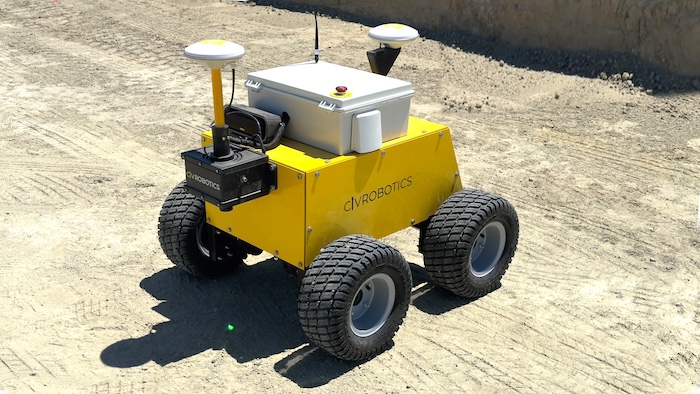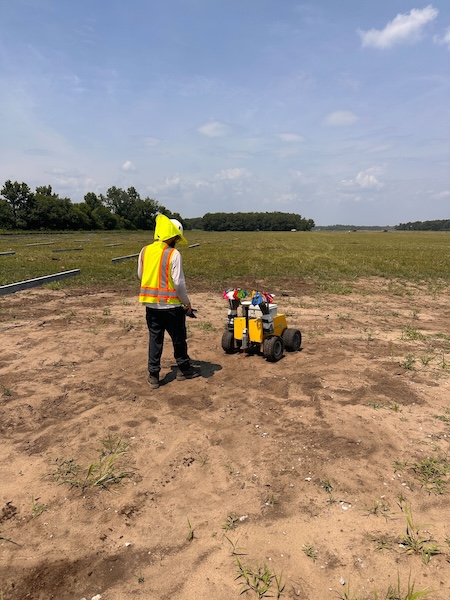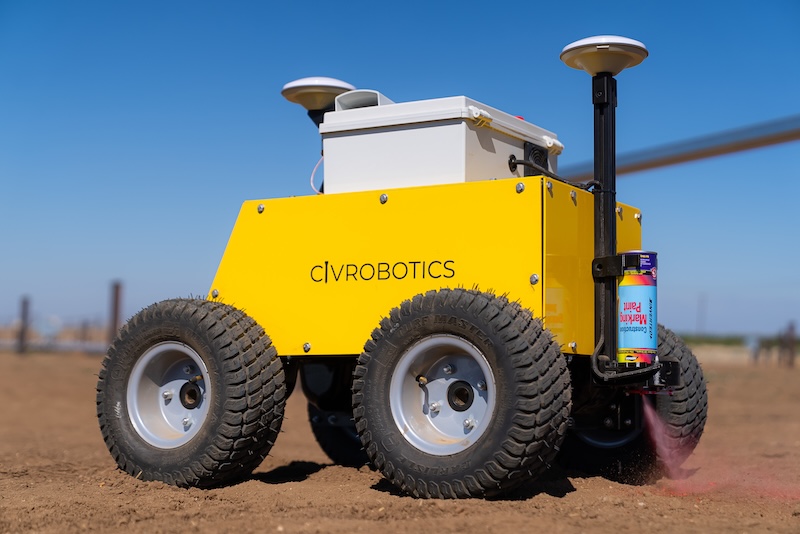How Robots Solve the Hidden Bottleneck in Solar Construction
It didn’t start with a robot. It started with a problem.
Clean energy is one of the hottest commodities today, and the world is rushing to meet this increasing demand. However, the typical financial barrier isn’t a problem for the industry; it’s labor. Skilled workers capable of installing solar infrastructure are needed more than ever, and there just aren’t enough to go around. This deficit is threatening the industry at a time when growth is needed more than ever. With U.S. energy demand expected to increase by 50 percent by 2040, and 90 percent of new energy capacity coming from solar, finding innovative solar-scale solutions has become priority number one. One promising solution stands out from the crowd: robot labor.

Identifying the gap
Surveying and site layout are essential components of any construction project, but remain largely manual. Crews walk job sites with GPS pole surveying equipment, marking thousands of points by hand. This process is slow, labor-intensive, and often inconsistent, which falls short of the increasing demands of modern project completion.
While other industries have rapidly embraced new innovations to address technological gaps, construction has lagged behind. This inefficiency is no longer acceptable in today’s hyperspeed world, and change is vital.
Solar construction demands more
While layout inefficiencies affect infrastructure projects across the board, solar presents particular challenges. Solar farms require 5-10 acres of space per megawatt, meaning a 100-megawatt installation could span 500-1,000 acres of land. Each square foot requires a pinpoint-accurate layout for piling, trenching, fencing, cabling, and more.
As these projects are often undertaken in remote areas, scarce labor and challenging environmental conditions present further roadblocks. Even minor layout mistakes can cause a domino effect across the site, leading to material waste, misaligned infrastructure, and costly reworks.
Rapid growth only increases the urgency: the U.S. installed over 40 gigawatts of solar in 2023, a 44 percent increase year-over-year. But while the demand could rise by 50 percent, projections from the U.S. Bureau of Labor Statistics forecast a mere 22 percent increase in solar installation workers by 2033.
It’s clear that urgent demand can’t be met with the current resources. So, what role can robotics play? On expansive sites where precision and efficiency are paramount, automation offers a scalable way to maintain quality while significantly reducing manpower requirements.
 Meeting field demands with robotics
Meeting field demands with robotics
Robotics offers a way to improve the layout phase of solar installation, reducing the strain on crews while increasing accuracy and output. In order to be effectively deployed, bots must have a few critical capabilities:
- High-accuracy positioning ensures that every coordinate is marked within tight tolerances, especially for the vital tasks of piling and pre-drilling.
- The ability to navigate uneven terrain allows operation in varied conditions such as mud, sand, snow, slope, and more, allowing for projects to be carried out quicker with no terrain preparation.
- The support for widely used file formats such as CSV and DXF makes integration with existing tech seamless, enabling layout data to move easily between planning software and field execution.
- Minimal training requirements do not require a certified surveyor. Crews with no previous robotics training can be up and running quickly.
When layout robots are designed with these features, they can fit naturally into existing workflows, particularly when compatible with industry-standard GNSS systems.
Scaling solar installation with automation
As the adoption of these robotic systems grows, the significant increase in productivity and improved project delivery become clear.
Gone are the days when on-site crews needed extensive training before they could dive in. Onboarding is quicker than ever, allowing companies to ramp up operations even in regions where skilled labor is scarce. By automating repetitive tasks like coordinate marking, teams can reallocate their workforce to more specialized roles, reduce rework, and maintain tighter control over project timelines.
Automation isn’t just a solution to labor shortages but also a move towards better efficiency, flexibility, and consistency across large infrastructure projects.

Realizing value across the project chain
And of course, these improvements have a wider financial impact. In solar construction, the increasingly massive scale is paired with tight margins; even minor errors can lead to expensive consequences down the line.
By reducing the likelihood of misalignment during key initial phases such as piling, racking, and trenching, leaders can stay within or even below budget. And for engineering, procurement, and construction teams, the ability to replace high-cost and labor-intensive processes with reliable automation provides clear cost savings. In the economics-driven renewable energy sector, lowering layout costs without sacrificing accuracy can’t be passed up.
Future-proofing clean energy infrastructure
The clean energy transition demands infrastructure delivered faster, at greater scale, and with fewer skilled hands onsite. Technologies that augment and empower human capabilities will define the next chapter of energy construction.
Robotics layout is the answer to these pressing needs and needs to be seriously considered by all industry players. Easy-to-use, cost-saving, highly accurate, and reliable, these bots unlock a new level of efficiency badly needed in this rapidly growing industry. As growth continues to explode, automation won’t just be an advantage, but a necessity crucial to project success.
Pooja Khandelwal is the Head of Marketing at Civ Robotics, where she leads strategy across digital, growth, and brand. With over a decade of marketing experience, Pooja specializes in helping early-stage startups craft high-impact marketing strategies that drive results from scalable lead generation campaigns and inbound optimization, to building brand awareness from the ground up.
Civ Robotics | www.civrobotics.com
Author: Pooja Khandelwal
Volume: 2025 September/October











.png?r=2284)
